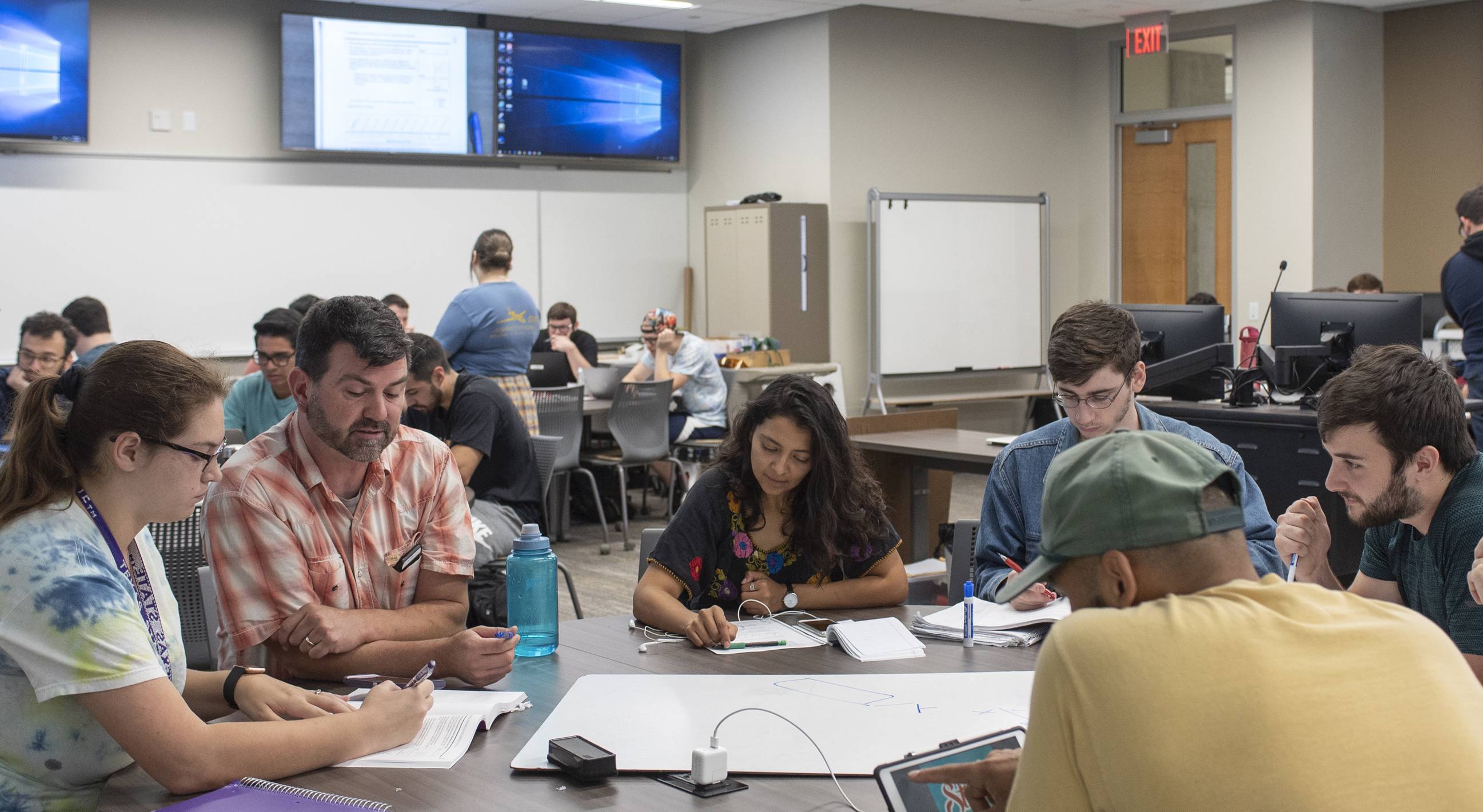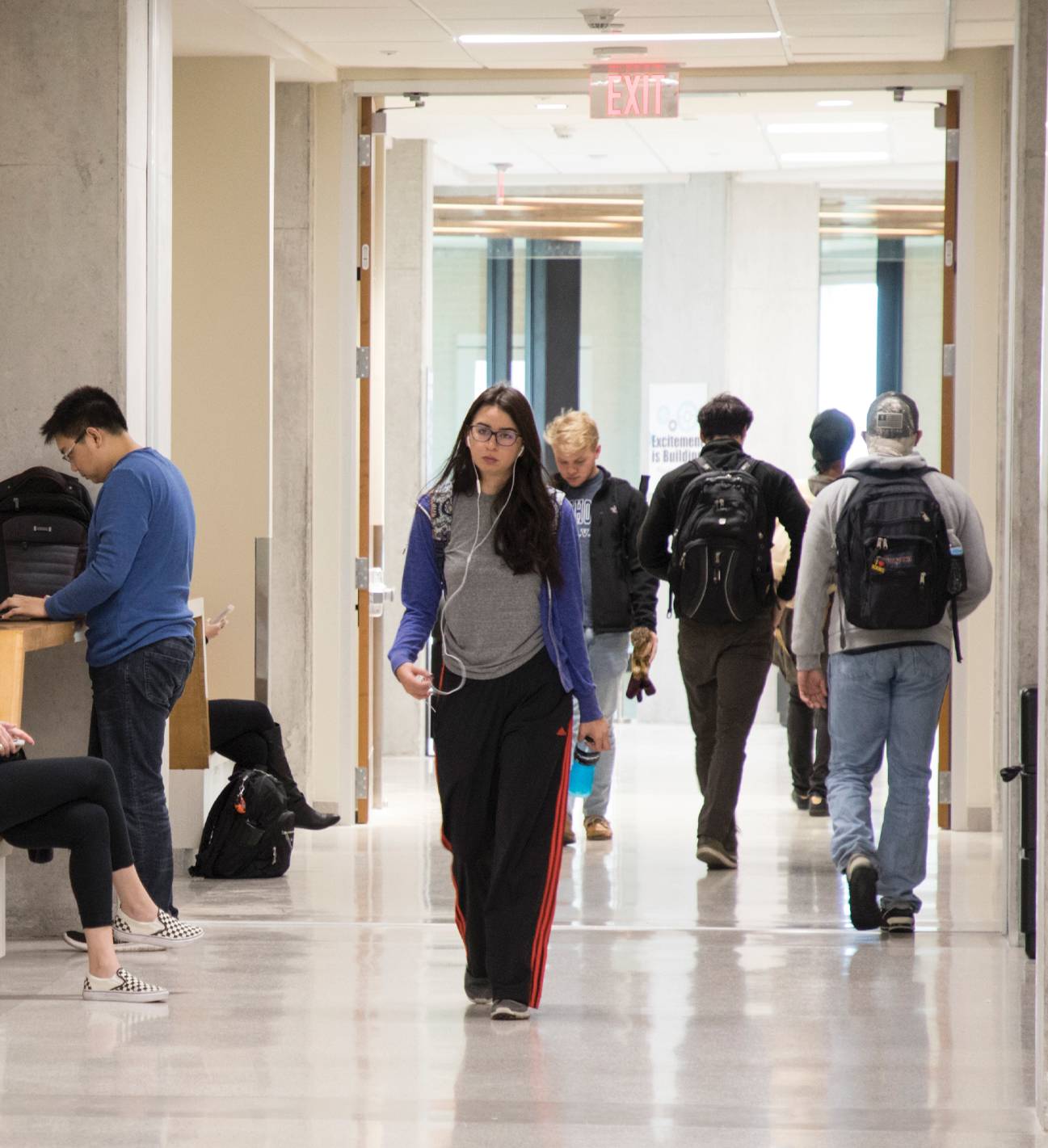
Inside Ingram Hall
by Dan R. Goddard
Science and engineering faculty behind Maker Spaces, cutting-edge design, and active leaning classrooms
As technology transforms industries, educational research is changing the way students are taught. Bruce and Gloria Ingram Hall, a new $120 million, five-story building, represents a significant investment in the future of science, technology, engineering, and mathematics (STEM) education and research. This engineering and science building boasts state-of-the-art equipment combined with cutting-edge design for “active learning” classrooms.
Instead of quietly lining up in desks facing a teacher and a blackboard, students are encouraged to interact, discuss problems, and engage in hands-on experiments. Ingram Hall, now the largest academic building at Texas State, features new spaces for the programs in biology, computer science, mathematics, and engineering as well as the Materials Science, Engineering, and Commercialization (MSEC) doctoral program. There are active learning classrooms for physics and biology, a campus-accessible Maker Space, and an extension of the System Modeling and Renewable Technology (SMART) Lab involving students directly in renewable energy research.
Dr. Christine Hailey, dean of the College of Science and Engineering, says each of the active learning rooms incorporates the latest educational research. For example, based on the Student-Centered Active Learning Environment with Upside-down Pedagogies (SCALE-UP) world-recognized instructional model from North Carolina State University, the physics classroom is furnished with eight, 7-foot diameter tables each seating nine students who can be easily divided into teams of three.
Faculty designed
“Several faculty helped design the active learning classrooms on the third and fourth floors of Ingram Hall. Each of these rooms was designed to support active learning, where students work together to come to understand a physics, biology, or engineering concept through hands-on experiences,” Hailey says. “In essence, if students are asked to figure out a physics principle or biology principle, they will understand it deeply and transfer their understanding to other problems.”
Dr. Hunter Close, associate professor and PhysTEC site leader in physics, says a traditional classroom expects students to be passive receivers of information. “In this environment, it’s hard for students to turn to each other to talk, hard to conduct experiments, and hard to find a common, large horizontal surface to write down ideas for others to see,” Close says. “The real work of physics is to engage with experiments and models, and to argue and ideate with peers.”
The big, round tables are intended to promote interactions among students and their intellectual work, whether on paper, on a computer or around a physical apparatus. Students can look in many directions to find screens displaying information. Portable whiteboards can be placed horizontally on the students’ workspaces. Large whiteboards all around the room are mounted vertically on rollers.
“These features make it much more natural for students to share their work with each other and in a way that makes their work visible to instructors from a greater distance,” Close says. “The most important technology in the room is not new, and few people might recognize it as ‘technology.’ Furniture and architecture are very important for shaping human activity, and mostly we aren’t aware of how our behavior is influenced by these things. Having furniture and a room layout that says, ‘talk to your neighbor and share your ideas’ has a strong effect on us.”
Active Learning
Dr. Kristy Daniel, associate professor of biology, says the prevalence of passive, teacher-focused learning has become such a national issue that a “call to action” is encouraging transformation of undergraduate education toward student-centered learning. One reason teachers give for not utilizing active learning is inadequate learning spaces. “In the new Ingram Hall, we designed classroom spaces in a manner that highlights an active-learning environment,” Daniel says. The biology department oversaw the design of two new classrooms, one with 25 seats and one with 100 seats. The small classroom has been designed as a smart, active learning environment with six, four-person tables, each outfitted with a monitor display, power access, wired and wireless laptop input, a document camera, and a built-in microphone. The large classroom, a mix between the traditional classroom model and a SCALE-UP active learning environment, is outfitted with six-person D-shaped tables so students can easily work in a group or face a presenter.

“The new classrooms offer a transformative environment where instructors are positioned to act as facilitators of student-centered learning,” Daniel says. “Rather than facing a defined front of the classroom, students sit in groups around tables while the instructor can move around the classroom and assist students as they work through course content together.” The configuration of furniture and technology in the new biology classrooms highlights students as the center of the learning environment and promotes collaborative interactions. “Shifting time from lecture dissemination to students involved in collaborative group activities leads to significantly higher learning gains,” Daniel says. “Students will be able to project and share their contributions to their peers via the digital displays both at their group table and to the whole class as appropriate. Student work can be saved and shared among group members so that learning and progress can continue beyond the classroom.”
Dr. Stan McClellan, professor of electrical engineering, says active learning is learning by doing. “The Maker Space is implicitly learning by doing,” McClellan says. The Maker Space is designed to enable complex, multidisciplinary projects by providing students with easy access to state-of-the-art equipment and tools. From old-school woodworking and welding to the latest in 3D digital printers and laser cutters, Ingram Hall’s 6,000-square-foot Maker Space brings together tools and equipment from the electrical engineering, industrial engineering, manufacturing engineering, and civil engineering programs once scattered around various campus workshops into a central, accessible location while adding new technology, safety features, and research facilities.
Ideas to finished project
Dr. Austin Talley, senior lecturer in manufacturing engineering, says the Maker Space is designed so students can fabricate almost anything they can imagine. “If we want to build a community of makers and doers, then we need to devote space to where they can work and invent,” Talley says. “Sometimes, the biggest roadblock to taking an idea to fruition is figuring out how to fabricate it. In the Maker Space, students will be able to take an idea from pencil and paper to a finished product. Our goal is to demystify the process and make it more accessible to all sorts of students. My goal is to have as many students using the Maker Space as possible and not just engineering students, because you never know who might come up with a good idea.”
Dr. Semih Aslan, associate professor in electrical engineering, says the SMART Lab devoted to renewable energy research doesn’t look at all like a traditional classroom. With an indoor work area connected to an outdoor patio, the SMART Lab will make it easier for students to do experiments outside — collecting data using solar panels, wind turbines, and sensors — and then do analysis indoors on computers. “Many times, renewable energy research includes indoor and outdoor equipment and components,” Aslan says. “The indoor and outdoor spaces of this lab make it possible to conduct many types of research projects. In addition, it is possible for different research groups to work together. Active learning requires students to have equipment, tools, knowledge, and space to convert theory into reality, and the SMART Lab makes this possible.” ✪